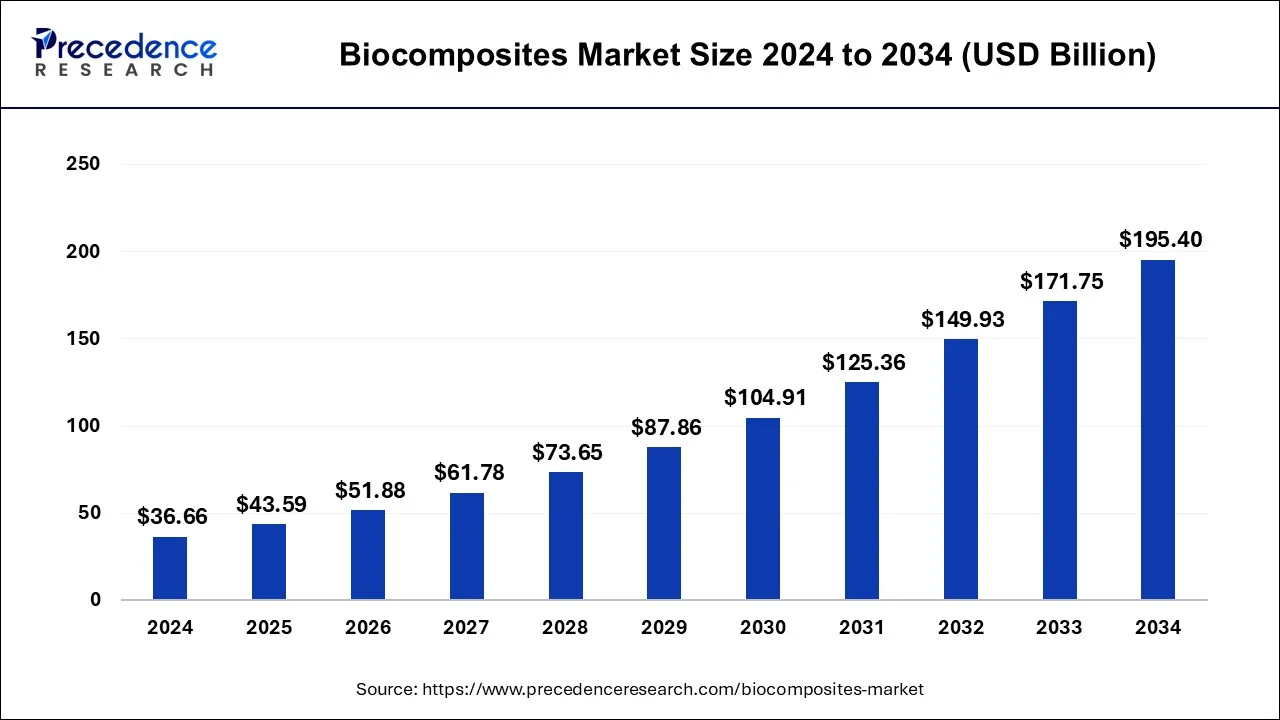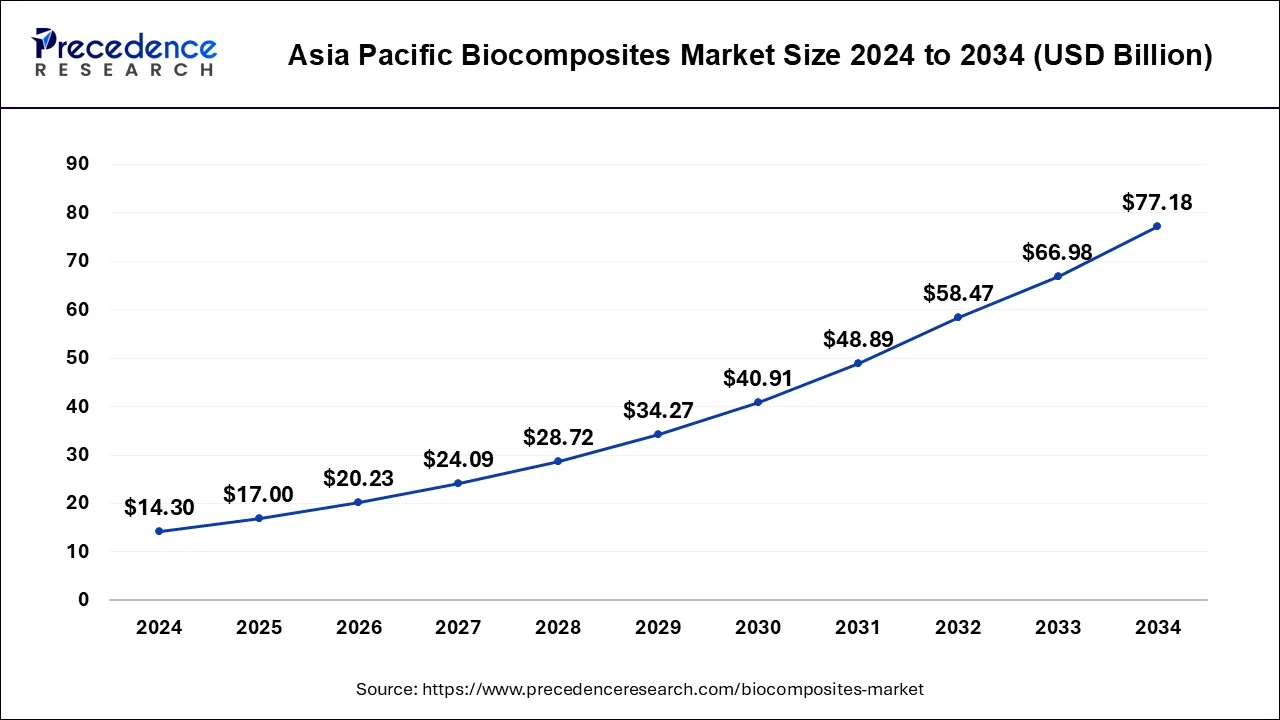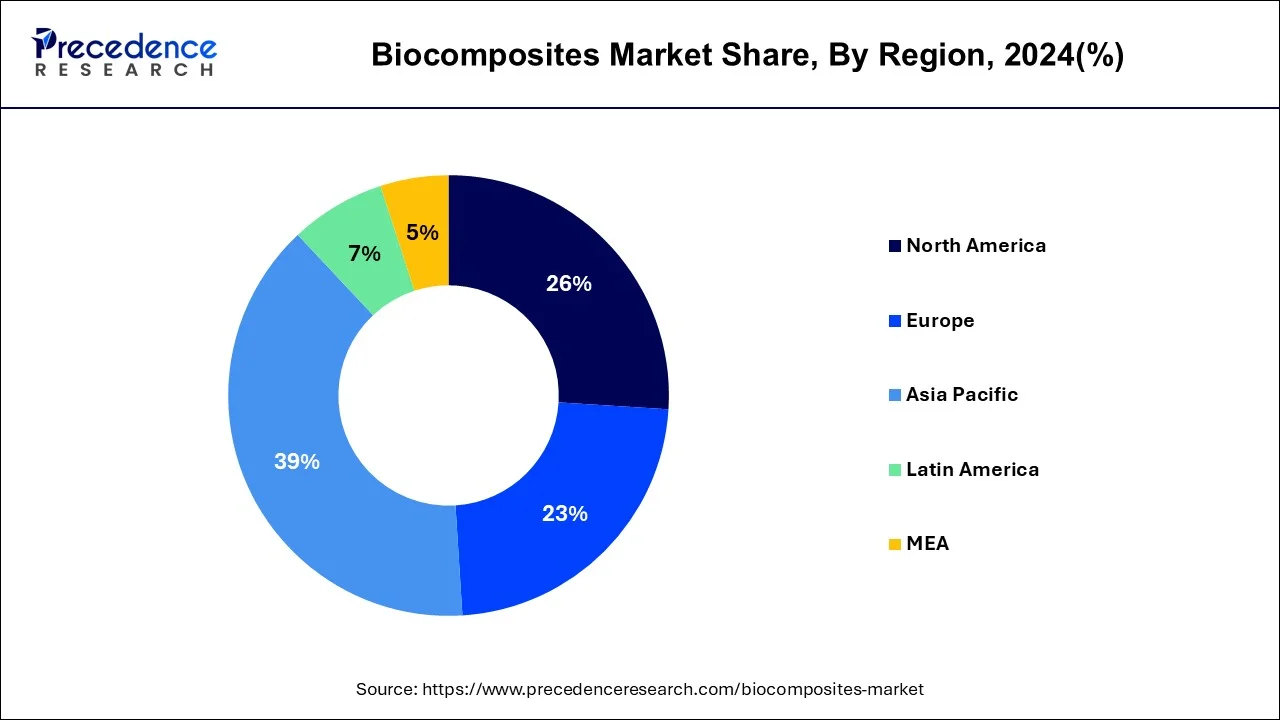The global biocomposites market size is estimated at USD 43.59 billion in 2025 and is predicted to reach around USD 195.40 billion by 2034, accelerating at a CAGR of 18.22% from 2025 to 2034. The Asia Pacific biocomposites market size surpassed USD 17.00 billion in 2025 and is expanding at a CAGR of 18.36% during the forecast period. The market sizing and forecasts are revenue-based (USD Million/Billion), with 2024 as the base year.
The global biocomposites market size was valued at USD 36.66 billion in 2024 and is expected to hit around USD 195.40 billion by 2034 and is poised to grow at a CAGR of 18.22% over the forecast period 2025 to 2034.

The Asia Pacific biocomposites market size reached USD 14.30 billion in 2024 and is anticipated to be worth around USD 77.18 billion by 2034, poised to grow at a CAGR of 18.36% from 2025 to 2034.

On the basis of geography, the Asia Pacific region is expected to have the largest market share in the coming years and this will be the largest market do to increase in the population. As the disposable income of the people in the Asia Pacific region is expected to grow the demand for biocomposite materials is also expected to grow in this region. In the countries like China as well as India the maximum population is middle class and it has a great demand for the automotive's as well as affordable housing. The growing demand for affordable housing and automotive's in the countries like China and India will help in the growth of the bio composites market during the forecast period.

The increasing population is one of the factors that will help in the growth of the market in the coming years period apart from the Asia Pacific region the demand for biocomposites is also expected to be good in the North American region as well as European region. As there has been a ban on the plastic that is non-recyclable by European Union, the demand for the biocomposites is expected to grow in the region. As the raw materials used in the manufacturing of bio composites are available on a large scale the demand for the biocomposites is expected to grow in the coming years especially for the regions like North America and Europe. Many market players are present in the North American region and the European region that have been instrumental in the growth of the market in the recent years and they will continue to be the driving force. The initiatives taken by the government in these regions are favorable which are supporting the adoption of biodegradable and recyclable products. The use of lightweight biocomposites has increased in the automotive sector as it helps in improving the efficiency of the vehicles.
With the help of the natural fibers like hemp flax, jute, industrial waste and wood and paper into polymer matrix are called biocomposites. Biocomposites are used in a large number of industries which range from automobiles to construction. As the bio composites are environment friendly the demand for biocomposites is expected to grow in the coming years. They offer a large range of benefits as they have better mechanical as well as physical properties due to which the market is expected to grow well in the coming years.
Although the use of bio composites in various industries like automotive packaging as well as construction had reduced due to the outbreak of COVID-19 pandemic recently the market is seen to grow as the restrictions across the world are relaxed. As the environmental laws adopted by various nations across the globe are becoming strict the bio composites market is expected to grow during the forecast period. Biocomposites are used as building materials as they are eco-friendly and they are preferred in the construction industry.
As the demand for the durable materials and the materials that are eco-friendly has grown in the recent years in the manufacturing industry the bio composites market is expected to grow well during the forecast period. Biocomposites are gaining popularity as compared to the glass fiber as they have many health issues associated with the use of the product. And there are many other issues associated with the use of the plastic composites due to which the demand for biocomposites has grown in the recent years. awareness regarding the ill effects of using harmful composites has grown in the recent years and the environmental laws have also become strict due to which the demand for the sustainable materials have grown and they will drive the market growth in the coming years.
| Report Coverage | Details |
| Growth Rate from 2025 to 2034 | CAGR of 18.22% |
| Market Size in 2025 | USD 43.59 Billion |
| Market Size by 2034 | USD 195.40 Billion |
| Base Year | 2024 |
| Forecast Period | 2025 to 2034 |
| Segments Covered | By Fiber Type, By Polymer Type, By Product, By Process Type, and By End User |
| Regions Covered | North America, Europe, Asia-Pacific, Latin America, and Middle East & Africa |
By fiber type, the wood fiber segment is expected to have a larger market share in the coming years period the demand for this type of fiber has grown due to its increased use in the outdoor construction activities. They are largely used in the construction of railings and decking. Apart from the use of the wood fibers the non-wood fiber segment is also expected to grow with a significant growth rate in the coming year. This type of a fiber is an alternative to the plastic fibers and the demand for the non-wood fibers is expected to grow in the packaging industry in the coming years.
Natural polymers segment is expected to grow well in the coming years. As that has been a growth in the use of the biodegradable products many consumers in various industries or demanding natural polymers. Rubber, wool cellulose and silk are the natural polymers that are used in the consumer products as well as the automotive industry.
Polyethylene polyester and nylon are the synthetic polymers available in the market synthetic polymers are being replaced by the organic or the natural substitutes and the natural polymers is expected to have greater demand in the coming years.
Based on product, the green biocomposite segment is expected to dominate the market in the coming years. this segment has dominated the market in the past with the largest market share in terms of revenue and it will continue to grow during the forecast period. The demand for this type of product is expected to grow in the coming years as it does not cause any harm to the environment. In most of the developed regions across the world like Europe and North America there has been a growth in the demand of these materials.
Green biocomposites have 100% biodegradability and this is one of the factors that will drive the market growth in the coming years. When it comes to the hybrid variants the demand for these products is expected to grow as they are lightweight and they also have higher strength but when it comes to biodegradability, they are not completely degradable
When it comes to the end user of biocomposites the transportation segment is expected to have the largest market share in the coming years. As bio composites are used in the manufacturing of the trucks and cars of various types the use of biocomposites is expected to grow in the coming years. Biocomposites are also used in the making of the interior panels. The use of these materials is expected to grow in the coming years as they help in reducing the weight of the vehicle and improves the efficiency. The manufacturing cost of the vehicle can also be reduced to a great extent due to the use of the biocomposites.
By Fiber Type
By Polymer Type
By Product
By Process Type
By End User
By Geography
For inquiries regarding discounts, bulk purchases, or customization requests, please contact us at sales@precedenceresearch.com
No cookie-cutter, only authentic analysis – take the 1st step to become a Precedence Research client